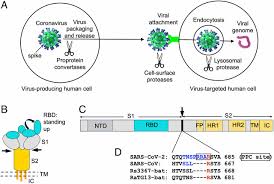The SARS-CoV-2 virus that causes COVID-19 is highly contagious. Strangely, in many patients, it can cause a poor immune response, thereby prolonging the disease. This contributes to the widespread of the virus and exacerbates the global pandemic. In a new study published in the Proceedings of the National Academy of Sciences, researchers at the University of Minnesota have discovered a biochemical mechanism that may explain how the virus can effectively infect humans while evading immunity reaction.

The study was led by Professor Fang Li of the School of Veterinary Medicine and studied the mechanism of SARS-CoV-2 entering cells. Specifically, this group of scientists studied how the virus uses the spike protein on the surface as a “key” to “unlock” human cells. They made three important discoveries:
- The tip of the virus key is tightly integrated with human cells;
- The tip of the virus key is usually hidden;
- When new virus particles are produced, the virus key has been pre-activated by human enzymes.
“Normally, when a virus develops a mechanism to escape the immune response, it loses its ability to infect humans,” Professor Li said. However, SARS-CoV-2 maintains its infectivity through two mechanisms. First, during the limited exposure time, the tip of the virus key will quickly and steadily grasp the receptor protein on the human cell. Second, the pre-activation of the virus key allows the virus to infect human cells more efficiently. ”
Professor Li said that recognizing the concealment of SARS-CoV-2 is important for the design of antibody drugs and vaccines. Antibody drugs need to hold the tip of the hidden virus key very quickly and tightly within a limited exposure time to subdue it. In addition, drugs can also target other key parts of the virus, which are more easily exposed.
Professor Li suggested that a successful anti-virus strategy needs to consider both the effectiveness of the virus and its concealment.
Reference
Jian Shang et al. Cell entry mechanisms of SARS-CoV-2, Proceedings of the National Academy of Sciences (2020). DOI: 10.1073/pnas.2003138117